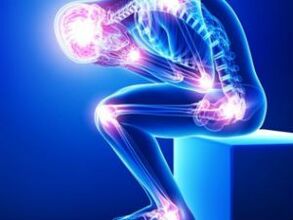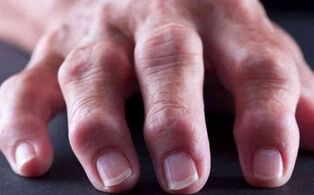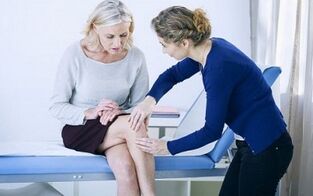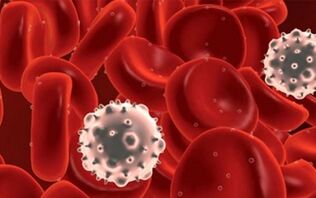
Joint problems often occur locally when a person has pain in a particular joint and can pinpoint the location of the pain. But sometimes joint pain cannot be localized because all or more joints hurt at once. To talk about rheumatoid arthritis in this case prematurely, because in addition to this pathology, there are other diseases in which the pain covers all the joints of the musculoskeletal system.
An attentive physician who analyzes a patient’s complaints and identifies causal relationships can identify the causes of all joints at once. Diagnosis is by no means always so simple, and with the most common general symptoms, it is not possible to highlight a particular pathology immediately after a series of examinations. Therefore, if you experience systemic joint pain, do not delay your visit to the doctor.
If all joints of the musculoskeletal system are severely ill, the following may be the cause:
- Autoimmune pathologies and systemic allergic reactions.
- Rheumatoid arthritis.
- Osteoarthritis.
- Chronic fatigue, increased physical activity.
- Poisoning the body.
- Diseases of the blood.
If pain occurs in several or all joints, we must immediately remember that such a situation is only a reaction to certain diseases, but not to individual diseases. The only exceptions may be pathologies such as osteoarthritis and rheumatoid arthritis, where the direct cause is cartilage damage itself.
Rheumatoid Arthritis
The disease refers to chronic autoimmune pathologies in which the joints of the whole body are primarily affected. The distinguishing feature of rheumatoid arthritis is that many joints are involved in the pathological process.
However, cytokines, metalloproteinase, and chemotactic cytokines play a key role in the inflammatory process. These are anti-inflammatory elements that activate the activity of the human body's own immune cells. As a result, they move to the site of inflammation, i. e. , the joints of the human body, and elicit a typical inflammatory response.
A typical manifestation of rheumatoid arthritis is damage to the peripheral joints and is symmetrical. When the disease worsens, the pathology affects the larger joints. The pathology mainly affects women, it is three times less common in men. It is diagnosed between the ages of thirty and fifty, but can sometimes occur in adolescents - a disease called juvenile arthritis.
Despite the fact that scientists have clarified the immune nature of the disease, the exact cause of rheumatoid arthritis has not yet been determined - why anti-inflammatory cells acquire such pathological activity. To date, there is evidence of a genetic predisposition to rheumatoid arthritis, also indicating that negative factors such as smoking, the spread of viral diseases, and so on, influence the appearance of pathologies.
The course of the disease is caused by the activation of immune complexes produced by the synovial membrane and found in the blood vessels. The rapid reaction to them is rheumatoid factors - antibodies produced to these complexes. In some cases, they occur on their own without the presence of provocative factors.
HELP!In the early stages of pathology, macrophages migrate to the affected areas, where the number of lymphocytes increases over time. The release of inflammatory mediators and provokes the development of the pathological process throughout the body.
When a chronic change in the synovium occurs, it becomes denser and rougher instead of the usual thickness, growing, and folds forming on its surface in the form of a fork. Cells in synovial fluid produce stromelysin and collagenase, which contribute to the destructive processes of cartilage tissue. The inflammatory process is enhanced by the production of prostaglandins, fibrin deposits and necrotic processes appear.
Overgrown synovial tissue triggers inflammatory mediators that play a role in destroying not only cartilage but also bone tissue, ligaments, and joint capsule. The number of leukocytes in the synovial fluid itself increases.
The small joints of the body are covered with characteristic rheumatic nodules when the shape of the joint changes and it looks ugly. The content of such rheumatoid nodules is the necrotic part of macrophages, fibroblasts, and plasma cells. Similar nodules are found in the internal organs.
The disease progresses gradually. Patients suffer from general and local joint manifestations - in the morning the joints show characteristic stiffness, fatigue, loss of appetite, body temperature rises to subfebrile. The condition of the joints improves about an hour after awakening. It affects the joints symmetrically, and in general, rheumatoid arthritis affects the following joints:
- Wrist.
- Second and third metacarpophalangeal.
- Shoulder
- Knee
- Ankle.
- Hip.
- Elbow.
In fact, the disease threatens any joint in the musculoskeletal system. Distal phalangeal joints as well as axial skeletal elements are least involved.

The joints remain painful, swollen and red, and become hot to the touch. To minimize painful feelings, patients try to bend the joints - so they hurt less. The progression of the disease occurs in the first 5-6 years after the onset of the first pathological changes. And already ten years after the pathology develops, irreversible changes appear in patients.
During this time, patients develop significant joint deformities and instability may occur. When the nerve branches are compressed, patients suffer from carpal tunnel syndrome, rheumatoid arthritis of the knee joint, patients with Baker cyst, deep vein thrombosis, and so on. He's threatening.
In parallel with the joint changes, out-of-joint manifestations of the body are observed, which develop as the pathology progresses in every third patient. Examples of such manifestations are rheumatoid node of the lung, vasculitis, Felty's syndrome, myocarditis.
Diagnosing the disease is not that difficult. Typical clinical criteria for rheumatoid arthritis have been demonstrated in the blood, increased erythrocyte sedimentation rate, and significant amounts of C-reactive protein and rheumatoid factor.
Patients' health is determined by x-ray, which is performed when rheumatoid arthritis is suspected. The disease can be distinguished from osteoarthritis, sarcoidosis, psoriatic arthritis and ankylosing spondylitis, arthritis underlying hepatitis C.
IMPORTANT!When making a diagnosis, it should be taken into account that the fatal outcome of the disease is quite high, but in rheumatoid arthritis it is not associated with joint damage, but with pathological changes of the heart and internal bleeding.
The disease is treated with supportive therapy as well as potent NSAIDs. We recommend that you only apply the right load to the joints, add movement therapy. If necessary, surgery is performed.
Osteoarthritis
Osteoarthritis is another common pathology that can affect both large and small joints. Various factors can provoke osteoarthritis, which primarily affects the cartilage tissue of the joint. The cartilage of the human body performs several functions and becomes a shock absorber primarily during various movements. Constant stress leads to increased wear on the cartilage.
If people with good health and strong immunity have a chance to repair damaged tissues, then in older patients, as well as in patients with increased joint stress, new fibers are hardly synthesized and cartilage does not recover. Traditionally, osteoarthritis has been seen as a consequence of mechanical effects on tissues, but now doctors also consider previously transmitted inflammatory diseases to be factors in the development of systemic osteoarthritis.
A typical symptom of the disease is joint pain as the matrix loses extremely important substances such as glucosamine and chondroitin sulfate. The absence of these elements leads to a so-called displacement of the joint, i. e. cracks of different depths appear in the cartilage tissue.
Inflammatory processes can also disrupt the normal structure of cartilage tissue, so doctors, when localized in the subchondral part of the bone, often diagnose microcracks in patients. The edges of the joint bone are covered with growths - osteophytes. They serve to compensate for the worn out part of the cartilage, but actually cause even more negative feelings in the patients.

Menopausal women are most susceptible to osteoarthritis.
Because the true cause of osteoarthritis has not been elucidated, doctors identify a number of factors that contribute to the development of the disease:
- Congenital insufficiency of cartilage tissue in which it can be very easily damaged. For example, patients with this pathology develop flat legs and are often diagnosed with dislocations - complete and incomplete.
- Gender is also a factor in the development of the disease, as statistics show that osteoarthritis is twice as common in women as in men.
- Age is typical - the disease usually develops in patients older than forty-five years, coinciding with menopause in women.
- Obesity.
- Metabolic problems.
- Increased sports load on the joints.
- Traumatic joint injuries.
The disease develops in any joint, but usually the starting joint is the most physically active. Can be localized in the knee joints, hips, elbows, etc.
The symptoms of the disease are very obvious, so osteoarthritis cannot be ruled out. In a person with an increased load, the joints begin to ache immediately, while the severity of the discomfort can vary: from a slight whining of the joint to the strongest sharp pain in the joint. With movement, the pain increases, becoming less pronounced at rest.
In parallel with the pain, patients suffer from rupture of joints and the appearance of stiffness. Patients have limited mobility. Especially at moments of disease progression when the pathology is associated with reflex muscle cramps.
At a later stage in the development of the disease, patients develop a characteristic joint blockage - a sharp pain when the joint suddenly stops moving due to severe pain in the joint. This is due to fragments of cartilage tissue entering the cavity, blocking movement. If the disease is accompanied by inflammation, there is swelling of the synovial membrane that can be easily seen.
The development of osteoarthritis is quite individual. In some patients, the x-ray shows signs of progression of the pathology, but it is felt that the picture of the disease does not change. However, other patients experience severe pain, inflammation, and limited mobility when the joint shown in the image appears satisfactory, according to the stage of development of the pathology.
Diagnosis of the disease is based on X-ray data and clinical symptoms of the disease. In parallel, you can perform ultrasound or magnetic resonance imaging if the presence of complications needs to be assessed.
Doctors try to treat the disease by taking into account the maximum preservation of joint mobility and the patient's ability to work. Therefore, in therapy, it is extremely important to stop the progression of the disease, eliminate joint pain, and relieve inflammation.
Currently, the options for treating osteoarthritis are not limitless, and treatment tactics are difficult to recognize as successful because joints cannot be repaired. The disease is in a chronic stage and you have to fight it all the time.
TIP!However, such unhappy predictions do not cause disability to patients - with successful therapy, you can learn to live with osteoarthritis and even maintain physical activity.
Doctors use the following groups of money for treatment:
- Non-steroidal anti-inflammatory drugs.
- Glucocorticosteroids.
- Chondroprotectors.
- Devices for activating blood circulation.
- Muscle relaxers.
Therapy for the disease consists primarily of drugs that are able to maximally restore cartilage tissue and create metabolic processes in the joint. Therefore, the main focus is on chondroprotectors, the use of which begins immediately after the inflammation is removed. Treatment with chondroprotectors is long-term and the best results only appear when starting treatment in time.
Other diseases
Rheumatoid arthritis and osteoarthritis are the most common pathologies in which joints ache throughout the body. But in addition to the drivers of morbidity, there are other conditions that cause pain in the joint joints.

Joint pain can be a manifestation of leukemia.
Aching joints can be a manifestation of blood disorders. Haematological pathologies today are the most difficult not only in the diagnosis of treating physicians but also in therapy. They are often accompanied by an oncological factor, and the diseases take on a completely different meaning for the patient. Usually, the joints of the whole body hurt in leukemia - acute and chronic. However, patients have no idea what this means, as blood test results show no abnormalities.
Joint pain is not isolated, it affects not only the joint elements but also the bones and muscles. Therefore, physicians advise patients with long-term painful feelings to consult not only an orthopedic traumatologist or surgeon, but also a hematologist who may suspect the pathology and refer the patient for further examination.
Body poisoning is another cause of joint pain. The fact that joints respond extremely sharply to the entry of toxins into the body, and if joints start to hurt and twist, occupational hazards, household waste poisoning, smoking, and alcoholism can be to blame. Patients suffer from extremely unpleasant symptoms - every joint hurts as if it has the flu, the general condition of the body suffers.
Improving patients' health is possible after diagnosis. They perform detoxification therapy, cleansing the blood and consequently the synovial fluid of toxins.
The most important
Pain in all joints in the body is not always associated with joint pathology. If the joints in the body are affected, it is usually caused by rheumatoid arthritis or osteoarthritis. The symptoms increase rapidly and the pathological process of the joints progresses.
In other cases where joint pain is not associated with joint damage, discomfort may be manifested by systemic diseases such as blood leukemia as well as osteoporosis, intoxication, infection. Coping with diseases is not that simple, but it is much more difficult to diagnose the disease. Patients who experience joint pain should contact the clinic in a timely manner to begin treatment early.

























